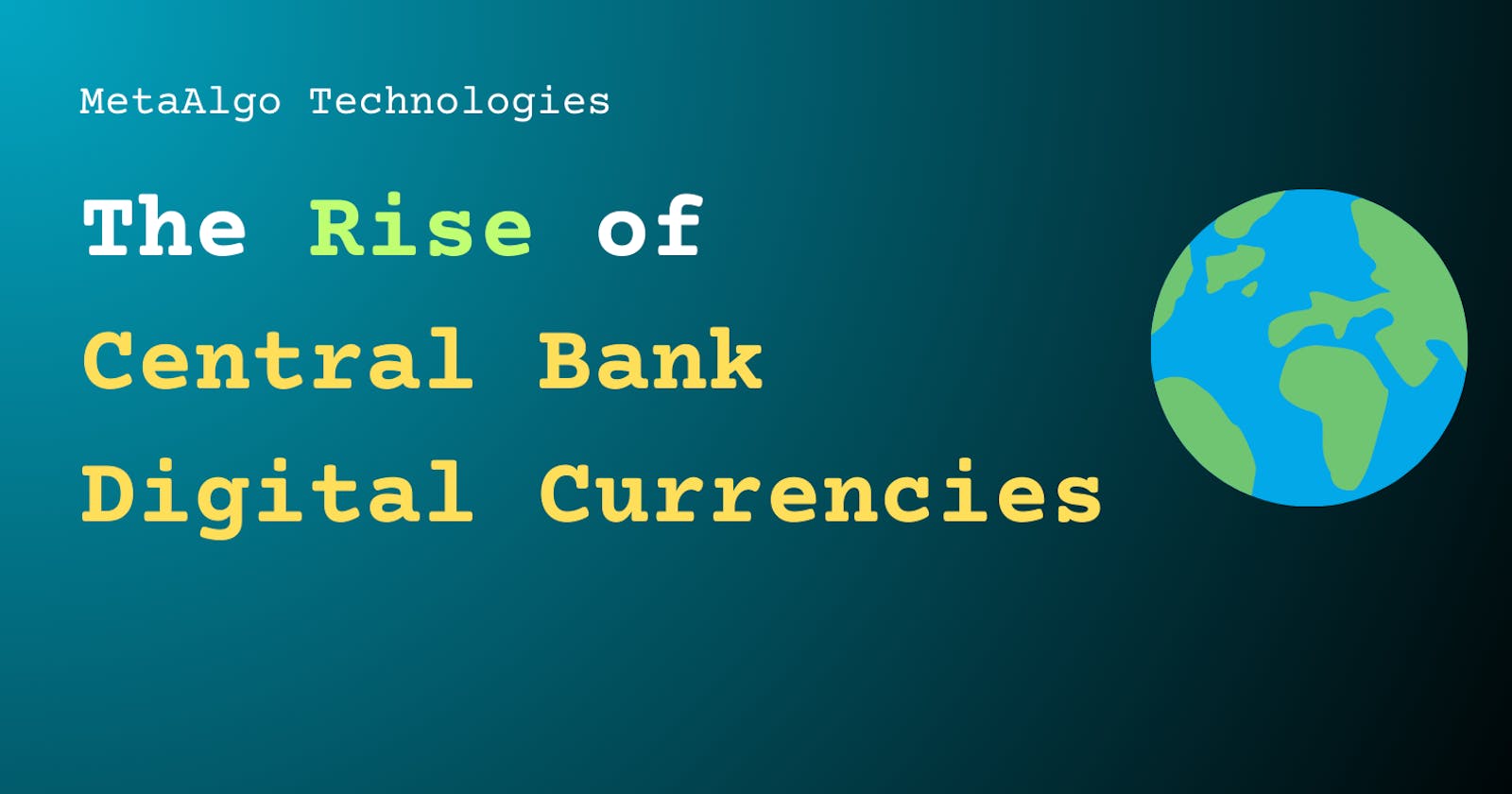The Rise of Central Bank Digital Currencies: A Technological Deep Dive
Unveiling the Technical Underpinnings of the CBDC Revolution
Table of contents
- About
- Core Concepts and Design Choices
- Technical Deep Dive
- Emerging Trends and Global Landscape
- Advanced Cryptography for CBDCs
- Privacy-Preserving Techniques in Depth
- Security Architecture beyond the Basics
- Central Bank Infrastructure Integration in Detail
- Global Landscape and Key Initiatives with Specificity
- Additional Challenges and Considerations in Depth
- The Future of CBDCs: A Speculative Exploration
- Conclusion
About
Central Bank Digital Currencies (CBDCs) are rapidly morphing from theoretical constructs to in-development projects, grabbing the attention of tech geeks and financial institutions alike. But beneath the hype lies a complex tapestry of technological choices, design architectures, and potential implications for the future of money. Let's embark on a deep dive into the world of CBDCs, dissecting their technical underpinnings and exploring the landscape of possibilities.
Core Concepts and Design Choices
At its core, a CBDC is a digital representation of central bank-issued currency, stored and transacted securely using cryptography. But beneath this seemingly simple definition lies a spectrum of design choices shaping the technical implementation. These choices revolve around:
Token-based vs. Account-based
Token-based CBDCs represent individual units of currency, similar to physical cash, while account-based systems track balances associated with user identities. Both approaches have trade-offs in terms of privacy, scalability, and programmability.
Distributed Ledger Technology (DLT)
While not mandatory, DLTs like permissioned blockchains offer potential benefits in transparency, immutability, and auditability. Choosing the right DLT, its consensus mechanism, and privacy features becomes crucial for CBDC design.
Interoperability
Seamless integration with existing payment systems and infrastructure is vital for CBDC adoption. This necessitates careful consideration of interoperability standards, communication protocols, and API design.
Offline functionality
Unlike some cryptocurrencies, CBDCs might need to function even in the absence of internet connectivity. Achieving this necessitates exploring offline payment mechanisms and digital wallet designs.

Technical Deep Dive
Now, let's delve into the specific technologies powering CBDC development:
Cryptography
Secure hash functions, digital signatures, and public-key infrastructure (PKI) are fundamental for ensuring data integrity, non-repudiation, and user authentication. Choosing robust cryptographic algorithms and key management strategies is paramount.
Privacy-preserving technologies
Balancing transparency with user privacy is a key challenge. Homomorphic encryption, zero-knowledge proofs, and multi-party computation hold promise for enabling selective disclosure and controlled data access.
Security architecture
Securing CBDC systems against cyberattacks is critical. This involves layered security mechanisms, intrusion detection/prevention systems, and robust governance frameworks.
Central bank infrastructure
Integrating CBDCs with existing central bank infrastructure for monetary policy operations and settlement systems necessitates careful design and testing.
Emerging Trends and Global Landscape
Hybrid models
Blending token-based and account-based approaches cater to diverse use cases and regulatory requirements.
Programmable CBDCs
Embedding programmable features allows for targeted fiscal interventions and conditional payments.
Cross-border CBDC
Collaborative efforts are underway to explore the feasibility of interoperable CBDCs facilitating international payments.
The global CBDC landscape is diverse, with various stages of development across countries. China's DCEP pilot is the most advanced, while many central banks are actively exploring proof-of-concept projects.

Advanced Cryptography for CBDCs
Post-quantum cryptography (PQC)
Traditional cryptographic algorithms might be vulnerable to future advancements in quantum computing. Incorporating PQC algorithms like lattice-based or code-based cryptography ensures long-term security for CBDC systems.
Multi-party computation (MPC)
This allows computations on sensitive data without revealing the data itself. Secure MPC protocols like SPDZ or Shamir's Secret Sharing scheme can enhance privacy while enabling collective tasks like transaction validation.
Homomorphic encryption
This allows computations on encrypted data without decryption, enabling functionalities like conditional payments or targeted monetary policy interventions while preserving user privacy. Exploring advancements in fully homomorphic encryption schemes like BFHE or YASHE is crucial.
Privacy-Preserving Techniques in Depth
Zero-knowledge proofs (ZKPs)
Beyond zk-SNARKs, exploring other variants like zk-STARKs (zero-knowledge Succinct Transparent ARguments of Knowledge) offers improved efficiency and transparency. Evaluating trade-offs between different ZKP schemes based on specific privacy requirements is vital.
Differential privacy
This adds controlled noise to data, protecting individual privacy while maintaining aggregate insights for policymakers. Implementing differential privacy mechanisms requires careful calibration to balance privacy and data utility.
Federated learning
This allows training machine learning models on decentralized datasets without sharing individual data. Exploring privacy-preserving federated learning techniques can enhance CBDC systems' capabilities while protecting user privacy.
Security Architecture beyond the Basics
Secure Multi-party Computation (MPC) for key management
Leveraging MPC protocols for key generation, distribution, and rotation strengthens security and mitigates single points of failure. Exploring threshold cryptography techniques allows sharing keys amongst multiple parties without compromising security.
Quantum-resistant Hardware Security Modules (HSMs)
As quantum computing advances, transitioning to quantum-resistant HSMs is crucial for long-term protection of cryptographic keys. Researching and adopting these solutions requires proactive planning and collaboration with hardware manufacturers.
Secure enclaves with remote attestation
Utilizing hardware enclaves with remote attestation capabilities ensures the integrity and trustworthiness of code execution environments within CBDC systems, further enhancing security.
Central Bank Infrastructure Integration in Detail
Central Bank Digital Identity (CBDID)
Establishing a secure and interoperable CDBID framework is essential for user identification and authentication within CBDC systems. Exploring integration with existing identity management systems and leveraging self-sovereign identity (SSI) concepts can streamline processes.
Programmable CBDCs with smart contracts
Embedding smart contracts into CBDCs enables conditional payments, targeted fiscal interventions, and automated functionalities. However, careful design and security audits are crucial to mitigate potential risks associated with smart contract vulnerabilities.
Offline functionality with digital wallets
Ensuring CBDC functionality even without internet connectivity requires exploring digital wallet designs that support offline payments and digital signatures. Secure element chips embedded in smartphones or dedicated offline wallets can be potential solutions.
Global Landscape and Key Initiatives with Specificity
Project Jura
A collaboration between the Bank of Canada and SIX exploring a CBDC for wholesale payments based on a permissioned blockchain.
Bank of International Settlements (BIS) Innovation Hub
Facilitates research and collaboration on CBDC development amongst central banks globally, including projects like the mBridge initiative exploring cross-border CBDC payments.
International Monetary Fund (IMF)
Provides technical assistance and policy guidance to member countries exploring CBDCs, fostering international cooperation and harmonization.
Additional Challenges and Considerations in Depth
Financial stability implications
The impact of CBDCs on money demand, liquidity, and credit intermediation needs careful analysis and potential mitigation strategies like tiered interest rates or reserve requirements.
Operational resilience and disaster recovery
CBDC systems must be designed with high availability, redundancy, and robust disaster recovery plans to ensure uninterrupted operation in case of disruptions.
Cybersecurity talent and expertise
Building and maintaining secure CBDC systems requires attracting and retaining cybersecurity talent with specialized skills in cryptography, secure coding practices, and threat intelligence.
The Future of CBDCs: A Speculative Exploration
Integrating CBDCs with the metaverse could enable seamless digital payments and financial transactions within immersive virtual worlds. Exploring technical standards and interoperability frameworks for such integration is crucial.
CBDCs could evolve into programmable, interest-bearing stablecoins offering alternative investment options and fostering financial inclusion. However, regulatory frameworks and risk management strategies need careful consideration.
The rise of CBDCs could reshape the global financial landscape, potentially impacting the role of commercial banks, the demand for physical cash, and the evolution of monetary policy. Exploring these potential implications and their long-term impact requires ongoing research and analysis.
The design and implementation of CBDCs must consider ethical concerns regarding data privacy, financial inclusion, and potential surveillance capabilities. Open public discourse and stakeholder engagement are crucial for ensuring responsible and ethical development of CBDCs.
As CBDCs evolve across different jurisdictions, international cooperation and collaboration on regulatory frameworks, technical standards, and cross-border interoperability will be essential to prevent fragmentation and ensure the smooth functioning of a global financial system.
Conclusion
The technical landscape of CBDCs is constantly evolving, presenting exciting opportunities and complex challenges. Understanding the intricate details of cryptography, privacy-preserving techniques, security architecture, and central bank infrastructure integration is crucial for navigating this dynamic space. As development progresses, continuous engagement with the latest research, active participation in global dialogues, and responsible innovation will be key to shaping the future of CBDCs and their impact on the global financial ecosystem.
Stay updated with the latest research and developments in the field.
Explore specific areas that pique your interest and delve deeper into their technical intricacies.
Engage in discussions and contribute to shaping the future of CBDCs through responsible innovation and ethical considerations.
I hope this provides you with a roadmap to continue your exploration of the fascinating world of CBDCs!
